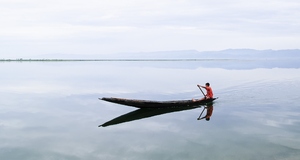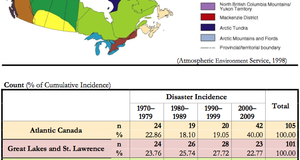From Earth Common Journal VOL. 4 NO. 1The Classic Maya Collapse: The Importance of Ecological ProsperityClassic Maya life heavily focused on art, science, mathematics, and religion and as the conditions of the environment and the political structure of Maya society worsened, both the culture and subsistence of Maya civilization were threatened (Hammond, 2000, p. 240). As these threats grew, the frustration of the inhabitants of Mayan cities increased and the people began to feel the full ramifications on a personal level. Because of the environmental degradation, they were unable to maintain their crops (Lucero, 2011, p. 480). As conditions worsened, their vulnerability grew and it became evident that future generations would be defenseless against the disastrous ecological state of the region that was left for them. Additionally, due to the intense environmental deterioration in the region, there was massive species loss and the Maya were not able to meet their protein requirements, which contributed to malnutrition and famine (Richardson, 2000, pp. 310-311). Religion played a significant role in Maya culture and much of their time was dedicated to religious practices and rituals, but as time passed and conditions did not improve, their faith in the world began to crumble (McKillop, 2004, pp. 221-223). While regional variability is a considerable factor to recognize, the overall breakdown of a society, whether it is swift or more gradual, is something that is felt through generations and Mayan vulnerability increased over the years. Ecological degeneration undoubtedly contributed to the societal issues that the Maya were faced with during the Classical Period in the southern lowlands. The collapse of the Classic Maya seemed rather inevitable considering the calamitous predicament they were faced with. The political system degraded most predominately through competition and lost trust in the ruler. Following this, the Maya people began to question their own existence due to loss of faith and witnessing all of the overwhelming external forces impacting their livelihoods.As the Maya population grew and flourished into a dynamic civilization, the increased demand for goods resulted in resource exploitation. Mass settlement, fuel and lumber demand, and agricultural development led to appalling deforestation, resulting in soil erosion from mismanaged agricultural practices and a depleted ecosystem. These conditions initiated a series of reactions from the Maya, contributing to their already declining condition. The political structure of Classic Maya society was already faced with fierce competition, which was increased as time passed and cities grew. Additionally, the dire ecological state was considered to be something that the Gods, and ultimately the Maya ruler, had control over and as conditions worsened the political legitimacy, Maya faith, and the entire Maya existence was questioned. DiscussionThe fall of the Classic Maya during the eighth and ninth centuries is a multi-disciplinary debate that has been going on for years. Both historically and presently, people have relied on the Earth for life and as seen with the Classic Maya, nature is in control of the world and human existence. This timeless nature-human relationship discussion is lengthy and complicated but it is something to keep in mind while reflecting on the series of events that followed the environmental degradation of the southern Maya lowlands. Although paleoclimatic and archaeological data have made remarkable contributions to the debate, there is still no universally accepted reason for the collapse of the Classic Maya. Additionally, there is no evidence that the millions of people who inhabited the southern lowlands migrated north or died (Richardson, 2000, pp. 98-100). However, it is universally accepted that their collapse can be explained through a combination of the two possibilities; some Mayans would have migrated, others would have stayed in their cities and attempted to overcome the adversities they were faced with, but ultimately most would have died (pp. 98-100). Conclusively, the eventual fall of the Classic Maya can be attributed to a combination of ecological and social factors but given the evidence, it is indisputable that the degraded environment laid the critical groundwork for the series of catastrophic events that followed. While there would have been some natural climate variability during the Classic Maya period in the Southern Maya Lowlands, there is a significant amount of research that indicates that Maya settlement, development, and activity had a substantial impact on the region and its ecosystems. The collapse of the Classic Maya can be explained through the causes and impacts of the megadrought. Although humans may need to use the resources provided by the Earth in order to survive, it is crucial to do so with great caution, understanding that they are not expendable. The collapse of the Classic Maya empire functions as a warning to current and future generations: humans are not separate from the natural world but they are a part of it. AuthorKatrina Armstrong is a student in the Bachelor of Arts program at MacEwan University. ReferencesAbrams, E. M., & Rue, D. J. (1988). The Causes and Consequences of Deforestation among the Prehistoric Maya. Human Ecology, 16(4), 377-395. doi: 10.1007/BF00891649 Curtis, J. H., Brenner, M., Hodell, D. A., Balser, R. A., Islebe, G. A., & Hooghiemstra, H. (1998). A multi-proxy study of Holocene environmental change in the Maya Lowlands of Peten, Guatemala. Journal of Paleolimnology, 19(2), 139-159. doi: 10.1023/A:1007968508262 Curtis, J. H., Hodell, D. A., Brenner, M. (1996). Climate Variability in the Yucatan Peninsula (Mexico) during the Past 3500 Years, and Implications for Maya Cultural Evolution. Quaternary Research, 46(1), 37-47. doi: 10.1006/qres.1996.0042 Fash, W. (2002). Religion and Human Agency in Ancient Maya History: Tales from the Heiroglyphic Stairway. Cambridge Archaeological Journal 12(1), 5-19. doi: 10.1017/S095977430200001X Golden, C., Scherer, & Andrew K. (2013). Territory, Trust, and the Collapse in Classic Period Maya Kingdoms. Current Anthropology, 54(4), 397-435. doi: 10.1086/671054 Hammond, N. (2000). The Maya. London: The Folio Society Lucero, L. J. (1998). Classic Maya Lowland Political Organization: A Review. Journal of World Prehistory, 13(2), 211-263. doi: 10.1023/A:1022337629210 Lucero, L. J. (2011) Climate Change and Classic Maya Water Management. Water, 3(2), 479-494. doi: 10.3390/w3020479 McKillop, H. (2004). The Ancient Maya: New Perspectives. New York: W.W. Norton Company. Richardson, G. B. (2000). Great Maya Droughts: Water, Life, and Death. Albuquerque: University of New Mexico Press. Wahl, D., Schreiner, T., Byrne, R., & Hansen, R. (2007). A Paleoecological Record for a Late Classic Maya Reservoir in the North Petén. Society for American Anthropology, 18(2), 212-222. doi: 10.2307/25063105 Webster, D. (2002) The Fall of the Ancient Maya. New York: Thames and Hudson. Webster, J. W., Brook, G. A., Railsback, L., Cheng, H., Edwards, R., Alexander, C., & Reeder, P. P. (2007). Stalagmite Evidence from Belize Indicating Significant Droughts at the Time of Preclassic Abandonment, the Maya Hiatus, and the Classic Maya Collapse. Palaeogeography, Palaeoclimatology, alaeoecology, 250(1-4), 1-17. doi: 10.1016/j.palaeo.2007.02.022 Suggested Reading from Inquiries Journal
Inquiries Journal provides undergraduate and graduate students around the world a platform for the wide dissemination of academic work over a range of core disciplines. Representing the work of students from hundreds of institutions around the globe, Inquiries Journal's large database of academic articles is completely free. Learn more | Blog | Submit Latest in History |



















